Occupational Environment Monitoring at the Mat Manufacturing Factory
99,000 ₫
Note: The above price is calculated for one sample, and the price may vary depending on the area of the environment to be monitored and market fluctuations. For more accurate pricing support, please refer to the quotation table or contact our consulting staff directly.
Occupational environment monitoring at a mat manufacturing factory is a process of collecting, analyzing, and evaluating workplace factors that may harm workers’ health.
Table of Contents
Toggle1. Overview of Mat Manufacturing Factory
a. What is a Mat Manufacturing Factory?
Mat manufacturing factory is a production facility specializing in producing and processing various types of mats. Mats are materials used for covering, spreading over beds, or for use in leisure, discussion, travel, or sports activities. Mats are usually made from fabrics, including various materials such as cotton, wool, silk, polyester, and other synthetic fibers.

b. Production stages in a mat manufacturing factory
The production stages in a mat manufacturing factory may include:
- Material preparation: Before starting the production process, primary materials such as fabric, fibers, and other components are prepared. Fabrics can be purchased from suppliers or produced in-house from fibers.
- Cutting and fabric treatment: Fabric is cut into small pieces according to desired sizes and patterns. Then, the fabric may be treated by washing, dyeing, or applying other technologies to improve color, softness, and durability.
- Sewing and processing: Fabric pieces are assembled and sewn into complete mats. Additional processing such as edge pressing, button sewing, attaching buttons, or embroidery can also be performed.
- Inspection and quality control: After processing, mats are thoroughly inspected to ensure quality and compliance with standards. Defects or errors can be detected and corrected.
- Packing and dispatch: Once finished, mats are packed and prepared for delivery to customers or retail points. Packing includes boxing, bagging, labeling, and preparing for transport.

c. Machinery used in a mat manufacturing factory
In a mat manufacturing factory, the following types of machinery and equipment may be used:
- Fabric cutting machine: Used to cut fabric into small pieces with desired sizes and shapes.
- Industrial sewing machine: Used to sew fabric pieces into complete mats. Industrial sewing machines typically operate at high speed with precise stitching.
- Processing machines: Includes equipment such as edge pressing machines, button machines, button attaching machines, embroidery machines, label cutting machines, and label printing machines. These machines are used for post-sewing processing.
- Dyeing machine: Used when fabric dyeing is required to achieve the desired mat color.
- Printing machine: Used to print images or patterns on mats.
- Pressing machine: Used to press edges or accessories on mats to enhance durability and aesthetics.
- Quality inspection machine: Used to check factors such as durability, elasticity, color, size, and other quality standards of mats.
- Packing machine: Used to pack mats after production, including boxing machines, bagging machines, and labeling machines.

d. Occupational diseases for workers in mat manufacturing factories
Workers in mat manufacturing factories may encounter some occupational diseases related to their work. Common occupational diseases include:
- Respiratory diseases: Working in environments with dust, chemicals, and irritants may cause respiratory issues such as pneumonia, asthma, bronchitis, and occupational lung diseases.
- Skin diseases: Prolonged exposure to chemicals can lead to dermatitis, skin irritation, psoriasis, and other skin problems.
- Spinal and related issues: Working in incorrect postures or lifting heavy objects may cause spine problems, such as back pain, cervical degeneration, and nervous system strain.
- Hearing-related conditions: Noise during mat production can cause ear damage, hearing loss, tinnitus, and other hearing issues.
- Eye diseases: Exposure to bright light, ultraviolet rays, and chemicals may cause eye inflammation, irritation, and other eye problems.
- Musculoskeletal disorders: Working in improper postures or lifting heavy objects may lead to musculoskeletal injuries, fractures, and related issues.
To prevent occupational diseases, safety and health measures should be applied, such as using personal protective equipment, ensuring good ventilation in the factory, following safe working procedures, and conducting regular health checks.

e. Common types of mats on the market
Below are some common types of mats:
- Sleeping mats: Standard mats used for sleeping and resting, usually made from materials such as cotton, down, natural or synthetic fibers.
- Cooling mats: Specially designed mats to help regulate body temperature. Cooling mats often feature temperature adjustment, sweat absorption, and antibacterial properties.
- Wool mats: Made from natural wool, providing warmth and comfort. Wool naturally regulates temperature, absorbs moisture, and has antibacterial properties.
- Silk mats: Made from high-quality silk, offering a luxurious, smooth, and cool surface, suitable for summer or sensitive skin.
- Cotton mats: Made from natural or synthetic cotton fibers, providing warmth and softness, ideal for winter or those seeking warmth.
- Electric mats: Equipped with an electric heating system to provide warmth. Temperature can be adjusted as desired, suitable for winter or those needing stable heat.
- Massage mats: Integrated with vibration units or muscle bundles to provide massage and relaxation effects. Massage mats help reduce stress, fatigue, and improve blood circulation.
2. Overview of Workplace Environmental Monitoring Services
a. What is workplace environmental monitoring in mat manufacturing factories?
Workplace environmental monitoring (or labor environment measurement) in mat manufacturing factories involves collecting, evaluating, and analyzing measurement indicators of workplace environmental factors at the factory. The purpose is to implement timely interventions, minimize environmental hazards to worker health, and prevent occupational diseases. Workplace environmental monitoring is a mandatory requirement for mat manufacturing factories.
Workplace environmental monitoring plays a crucial role in protecting, maintaining, and improving worker health because employees are the primary resource of a business and directly generate its profit. Workers who are frequently exposed to hazards exceeding allowable limits may suffer health issues and occupational diseases.
REGISTER FOR WORKPLACE ENVIRONMENT MONITORING SERVICE
b. Nam Viet’s Workplace Environmental Monitoring Program
Nam Viet’s Workplace Environmental Monitoring Program is developed by monitoring engineers specializing in occupational safety and environmental protection. To ensure worker health and safety, the program uses modern measurement methods to monitor air quality, water, microclimate factors, physical conditions, dust, and more in the workplace. This program is essential to ensure a safe working environment and protect worker health.
Additionally, Nam Viet’s program plays a vital role in researching and developing new solutions to improve workplace environment quality. With the dedication and professionalism of the monitoring experts, Nam Viet’s exclusive program is a breakthrough in occupational safety and environmental management in Vietnam.

c. Standardization in workplace environment measurement procedures
Standardization in Nam Viet’s workplace environment measurement procedures is crucial for ensuring measurement accuracy and reliability. To guarantee precise and trustworthy results, the program applies recognized standards and procedures from Ho Chi Minh City Department of Health. This ensures that collected data can be reliably used for workplace environment assessment and decision-making to improve worker health protection.
These standardized procedures also ensure that measurements are conducted by qualified monitoring experts with years of experience, allowing managers and specialists to trust results from An Toàn Nam Việt and make accurate, valuable decisions for safeguarding worker health and the environment.
By applying standardization in measurement procedures, Nam Viet demonstrates its commitment to ensuring a safe working environment and protecting worker health, while contributing to the development and enhancement of occupational safety and environmental management quality in Vietnam.
d. Workplace environmental monitoring reports in mat manufacturing factories
Workplace environmental monitoring results are prepared according to Form No. 04, Appendix III issued with Decree 44/2016/ND-CP and made in two copies: one copy is sent to the contracting workplace, and one copy is kept by the organization performing the monitoring.
The retention period of monitoring results, according to the law, is indefinite.

e. Frequency of workplace environmental monitoring as per legal regulations
According to Clause 2 of Article 18 of the Law on Occupational Safety and Hygiene 84/2015/QH13, employers must organize workplace environmental monitoring to assess harmful factors at least once a year.
f. Deadline for submitting workplace environmental monitoring reports as per legal regulations
The report submission deadline is before December 31 each year. Enterprises in manufacturing facilities are required to submit workplace environmental monitoring reports to the local Department of Health where the production or business facility is headquartered and where employees work.
If there are changes in technology, production processes, or during facility renovation or upgrading that may generate new hazardous factors affecting worker health, manufacturing enterprises must update their occupational hygiene records concerning factors that require environmental monitoring.
g. Penalties for violations of workplace environmental monitoring regulations for employers
According to Article 27 of Decree No. 12/2022/ND-CP dated 17/01/2022 on administrative penalties in labor, social insurance, and Vietnamese workers working abroad under contract:
- Clause 2: Fines ranging from 2,000,000 – 5,000,000 VND for employers who fail to publicly inform employees at the monitored workplace and inspection site about results immediately after monitoring and hazard assessment.
- Clause 3: Fines ranging from 20,000,000 – 40,000,000 VND for employers who fail to conduct workplace environmental monitoring to control harmful effects on worker health according to the law.
- Clause 4: Fines ranging from 40,000,000 – 60,000,000 VND for employers who collaborate with monitoring organizations to commit fraud in monitoring activities, but not to the level of criminal liability.
3. Harmful Environmental Factors for Workers in Mat Manufacturing Factories
In mat manufacturing factories, there are several environmental factors that can be harmful to workers. Below are some of the potentially hazardous environmental factors:
- Dust: The mat production process can generate dust from materials used such as cotton, feathers, natural and synthetic fibers. Dust can irritate the respiratory tract, cause pneumonia, and other respiratory issues.
- Chemicals: During production, chemicals such as additives, solvents, and adhesives may be used. Exposure to these chemicals can cause irritation to the skin, eyes, respiratory and digestive systems. Additionally, some chemicals can be highly dangerous, such as carcinogens or neurotoxins.
- Temperature and humidity: Mat production may create environments with high temperatures or humidity. Excessive heat or low humidity can make work difficult, causing fatigue, shortness of breath, and other health problems.
- Noise: Machinery and equipment in mat manufacturing factories, can generate loud noise. Continuous and high noise levels can cause stress, sleep disturbances, cognitive impact, and hearing problems.
- Lighting: The working environment in mat manufacturing factories may have strong or glaring light. Continuous exposure to glare can cause eye strain, fatigue, headaches, and difficulty concentrating.
- Air pollution: During production, emissions, organic vapors, and chemical odors may occur. Exposure to polluted air can irritate the eyes, nose, throat, cause headaches, and other health issues.
REGISTER FOR OCCUPATIONAL ENVIRONMENT MONITORING SERVICE
4. Measures to Improve the Working Environment in Mat Manufacturing Factories
To improve the working environment in mat manufacturing factories, the following measures can be applied:
- Safety and health management system: Implement occupational safety and health regulations, ensure the use of personal protective equipment, and provide staff training on safety and health.
- Dust control: Apply dust reduction measures, protect respiratory health, use dust extraction systems, and maintain workplace cleanliness regularly.
- Chemical management: Use safe chemicals, comply with procedures and regulations for chemical handling and storage, and provide full safety information.
- Temperature and humidity control: Provide air conditioning systems, ventilation fans, and ensure comfortable temperature and humidity conditions in the factory.
- Noise control: Provide ear protection, soundproof or insulate machinery and equipment, and identify measures to reduce noise at the source.
- Lighting: Use soft lighting, ensure sufficient light for work without glare or reflections.
- Air pollution control: Ensure proper ventilation, regularly inspect and maintain air treatment systems, and comply with emission and environmental standards.
- Regular health checks: Conduct periodic health checks for workers and monitor health issues arising from working in the mat production environment.
- Periodically perform occupational environment monitoring in the factory, collect and analyze harmful factors for workers, and adjust to reduce risks to prevent occupational diseases.
5. Benefits of Periodic Monitoring in Mat Manufacturing Factories
An Toan Nam Viet provides enterprises with excellent benefits when using occupational environment monitoring services according to Decree 44/2016/ND-CP on management and control of harmful factors in the working environment affecting employees.
- Enterprises can proactively control harmful factors in the factory or workshop.
- Receive recommendations on measures to minimize harmful factors and improve the quality of the working environment.
- Indirectly protect human resources, the main factor in business development.
- Reduce the impact of occupational diseases on health, thereby lowering future treatment costs.
- Improve workers’ health, ensuring product quality and maintaining production output.
- Comply with occupational safety laws and avoid legal risks.
- Enhance credibility and professionalism, thereby elevating the enterprise’s brand.
Nam Viet’s environmental monitoring service is a solution to reduce occupational disease risks, contributing to a clean and high-quality working environment.

6. Nationwide Occupational Environment Monitoring Center
The Occupational Environment Monitoring Center of Nam Viet is a professional unit specializing in supervising and measuring occupational environment quality across all provinces in Vietnam. With a team of experienced monitoring specialists, the center uses modern measurement equipment to ensure accuracy and reliability.
In addition to providing monitoring services, the center assists clients in planning, handling, and tracking occupational environment issues. With the motto “customers at the center,” the center prioritizes customer satisfaction, meets all client needs, and commits to offering the best solutions for businesses.
REGISTER FOR OCCUPATIONAL ENVIRONMENT MONITORING SERVICE
With investments in technology, equipment, and personnel, Nam Viet’s monitoring center has become a reputable unit in occupational environment monitoring in Ho Chi Minh City, with the following goals:
- We always value brand reputation and service quality.
- We provide clients with the best and most suitable solutions possible.
- Alongside experienced Masters and Engineers committed to environmental protection and business benefit.
- By working with Nam Viet Environmental Monitoring, your company will receive professional service from experts in the field, along with the best cost benefits.
The occupational environment monitoring process at Nam Viet includes the following basic steps:
- Before monitoring, we ensure that all equipment is calibrated according to legal regulations.
- Strictly follow the occupational environment monitoring procedures committed to the Department of Health.
- Report monitoring results honestly to the employer.
- If the results indicate unsafe conditions for workers, Nam Viet will provide solutions, and the workplace will:
- Implement measures to improve working conditions to minimize harmful effects and prevent occupational diseases.
- Organize health examinations to detect occupational and work-related diseases early for employees in unsafe positions.
- Provide material compensation for workers according to labor law regulations.

7. Occupational Environment Monitoring Pricing
To help enterprises conduct professional and effective occupational environment monitoring, Nam Viet provides customers with a detailed and reasonably priced service quotation.
- Our pricing table provides detailed information on the costs of monitoring services, including travel, measurement, analysis, and reporting fees. Clients can rely on the accuracy and reliability of our monitoring reports.
- We commit to offering the most competitive and reasonable prices on the market and are always ready to provide fast and professional consultation on monitoring services.
- With Nam Viet’s quotation table, clients can easily select service packages that suit their needs. We guarantee maximum satisfaction with our professional service quality.
No comments yet

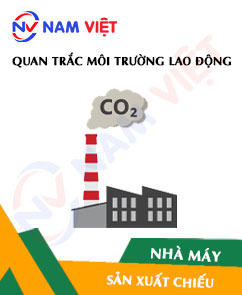
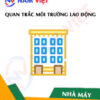
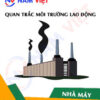
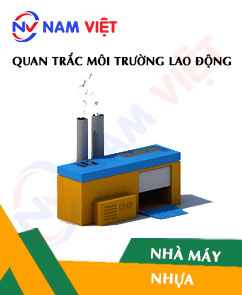
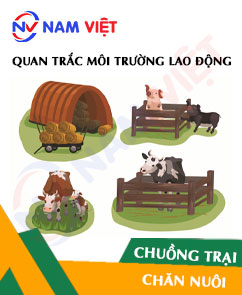






Review Occupational Environment Monitoring at the Mat Manufacturing Factory
There are no reviews yet.